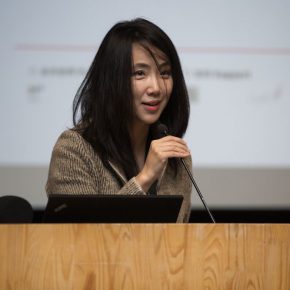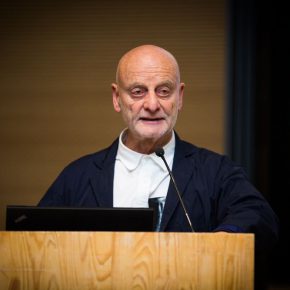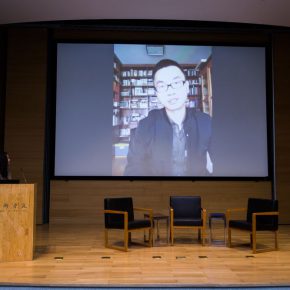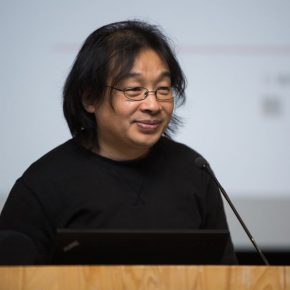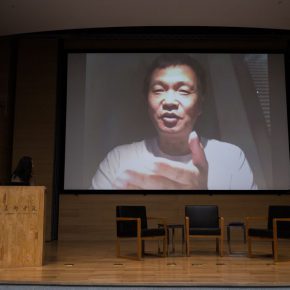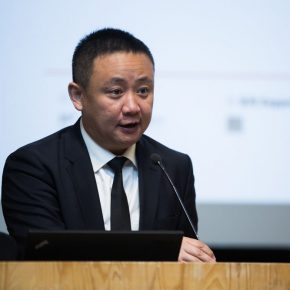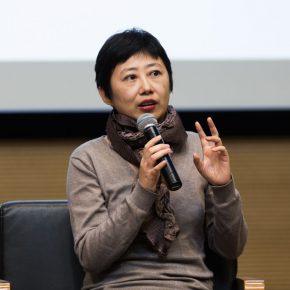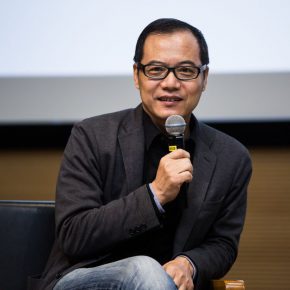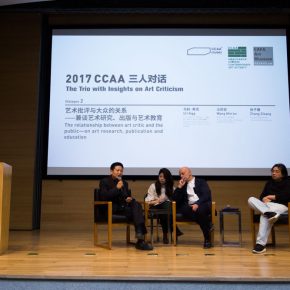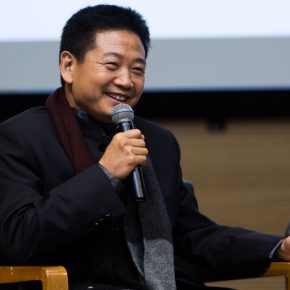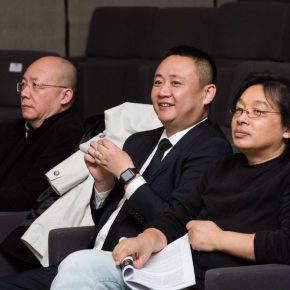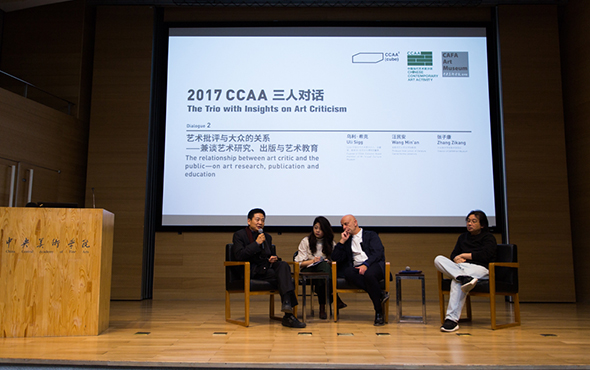
The press conference of the “2017 CCAA Chinese Contemporary Art Critic Award” was held at the Auditorium of CAFA Art Museum at 10:00 on 8 November. After this year’s jury discussed and reviewed the 24 submitted written proposals, it announced that the 2017 critic award is to be presented to Lu Mingjun, Associate Professor of Art History at Art College, Sichuan University. At the same time, in order to mark the 10th anniversary of the CCAA Chinese Contemporary Art Critic Award, the jury decided to give a special prize to Zhang Xianmin, Professor of Literature at Beijing Film Academy, for his proposal of “Moving Image in Public”. It offers a grant of 80,000 RMB for research that has to be completed independently in 1-2 years, and the publication of the resulting essay in Chinese with an English version.
The four international and domestic judges include: Uli Sigg, Founder of CCAA Chinese Contemporary Art Award, Swiss collector for Chinese contemporary art, and Board member of M+ Visual Culture Museum, Charles Guarino, from New York, the publisher of Artforum International Magazine, Pi Li, senior curator of CCAA’s long-term strategic partner Hong Kong M+ Visual Culture Museum, Wang Min’an, Professor and Ph.D. advisor from School of Literature of Capital Normal University. Liu Li Anna, the president of CCAA, moderated the press conference.
Lu Mingjun’s “Frontier Vision” Won the 2017 CCAA Chinese Contemporary Art Critic Award and Zhang Xianmin Won the Special PrizeOn behalf of the jury, Dr. Uli Sigg awarded Lu Mingjun’s proposal for his seeking of a new art-political sensibility, which is different from both overly optimistic global narrative and that of nationalism. Lu seems to be capable in presenting a cogent and compelling case that has an urgency that speaks to an agenda very much tied to our time. Lu Mingjun holds that the growing trend towards ethnic separatism and the returning of political conservatism in recent years prove that the global narrative is facing severe challenges. In the much more complicated and brutal post-globalization world, ethnicity, religion, frontiers and the national narrative of China have become widely-debated topics once again, indicating an urgency to rethink the world geopolitics, economic and cultural structure. Lu’s proposal attempts to renew our perception of borders, frontiers, identity, and their relationship to artistic practice in China today.
Zhang Xianmin is one of the most important advocates and critics in the field of Chinese independent moving image. The special prize winning book proposal “Moving Images in Public” will focus on another genre of moving images, those that fall into oblivion for various reasons such as over-exposure, over-appropriation, and excessive circulation in the public sphere. Zhang Xianmin’s research will investigate them with an insightful vision, taking them as a sign of landscape art, thus to explore the public aesthetic tastes and opinions hidden in them and then discuss the productions, popularity and distribution which are wedged into a whole social production system. Zhang’s proposal does not focus on individual artistic creation as conventional art criticism may do. Instead, his research touches upon a wider scope of visual and media culture highly relevant to contemporary art. On behalf of the jury, Wang Min’an read the jury’s statement that after ten years of supporting independent art criticism in China, the jury now intended to encourage critics to reach beyond perceived borders, beyond a narrow definition of contemporary art.
After the winners were announced, Dr. Pi Li summarized the selection of work on behalf of the jury. As the first art critic award in China, the CCAA witnessed the ten years of development and changes of contemporary Chinese art critics since 2007. It is the 10th anniversary of the establishment of CCAA Chinese Contemporary Art Critic Award in 2017, and it invited the jury of the year including Uli Sigg, Pi Li and Wang Min’an, as well as Zhang Zikang, Director of CAFA Art Museum, Wang Chunchen, Deputy Director of CAFA Art Museum and Winner of the 2nd CCAA Chinese Art Critic Award in 2009 and Yu Miao, Winner of the 5th CCAA Chinese Art Critic Award in 2015 for discussions on the status and development of art critics.
CCAA Dialogue 1: Pi Li × Wang Chunchen × Yu Miao – the Role of CriticismDialogue 1: “The Role of Criticism” invited Pi Li, Wang Chunchen and Yu Miao to review the changes and developments in art critics in the past 10 years since the establishment of the CCAA Chinese Contemporary Art Critic Award, and shared their views on the current status of art critics. Yu Miao said that domestic exhibitions have developed to an exhibition economy, art media and art writers were coerced into this rapid production of an exhibition, and there was a lack of writing based on long-term observation from an historical perspective. Pi Li agreed that the development of Chinese exhibitions has created the 2500-word gallery preface, which missed the basic academic nature, then how did the critic regain academic dignity? Under such circumstance, it is necessary for the critic to seek the possibility of new methodologies in other fields and it might expand to the new media, visual culture and literary theory in addition to the traditional writing of art history. Wang Chunchen did not think that social changes lead to the lack of the role of criticism, and he believed that the role of criticism became more powerful because of personal efforts and perseverance. The ways of writing on self-media and social media were also part of the criticism of contemporary China. In fact, the current publications have never diminished. The past media-oriented writing has turned into academic writing in the university.
CCAA Dialogue 2: The Relationship between Art Critic and the Public – On Art Research, Publication and EducationDialogue 2: “The Relationship between Art Critic and the Public – On Art Research, Publication and Education” invited Uli Sigg, Wang Min’an, and Zhang Zikang for a dialogue on whether the current art critic is disconnected with the public or not, questioning whether the professional art research misses an audience, to further resolve the relationship between art critic & public art education. Zhang Zikang believed that art museums should cultivate the ability of thinking of the public, and the valuable critic was effective. The academy teaches classical knowledge, and art museums often break this perception: the openness of the critic of an art museum opens a professional window for non-artisans, so that they can gain academic knowledge. Wang Min’an believed that under the current training system of university, “ordinary students from colleges & universities were poor in the knowledge of art history”, however, some students soon became interested in art by visiting galleries and exhibitions. Art museums & exhibitions are actually more important and more inspirational than the courses. Uli Sigg said that the foreign non-art history students also had a gap in contemporary art at the same time, the lack of an exchange between contemporary art and the audience was reflected in different regions. For those who did not have a corresponding art resource, art critics are a channel close to the public media, and the role of art journalists can help art critics enter the publicvision.
Through dialogues, Western and Chinese scholars started from the exhibitions and events planned in recent years to discuss the roles of art critics in their respective work, as well as the individual opinions on the status quo of criticism. The role of criticism itself was extended to the discussion with the audiences and the relationship between both, presenting the thoughts of the process of selection in this way at the same time.
Text by Wu Huixia, Edited by Zhu Li and Photo by Yang Yanyuan/CAFA ART INFO
Translated by Chen Peihua and edited by Sue/CAFA ART INFO


